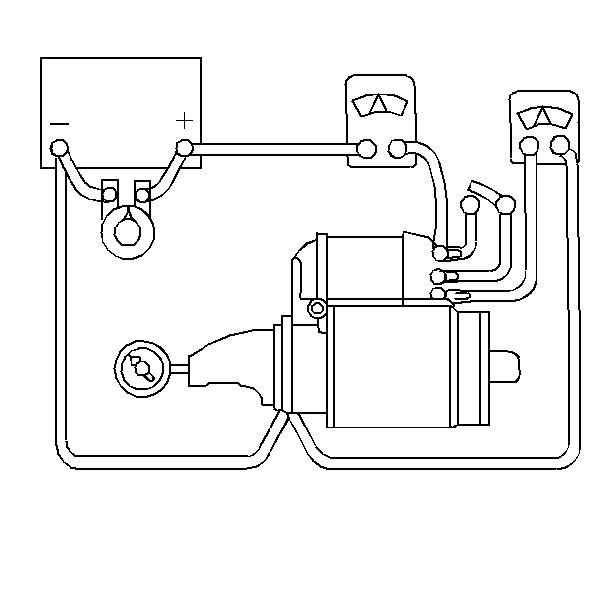- Remove the starter motor from the vehicle. Refer to
Starter Motor Replacement
.
- Secure the starter motor in a vise or suitable test stand.
- Turn the carbon pile off and open the switch.
Caution: Keep fingers, tools, and any other objects away from the opening in
the drive end housing while making electrical connections. The strong shifting
action of the starter solenoid can cause severe personal injury
or damage to components as the drive pinion moves into the cranking position.

- Connect a voltmeter from the starter motor terminal to the starter motor
frame (ground), as shown.
- Connect the starter motor and an ammeter in series, from the positive
terminal of a fully charged 12 V battery.
- Connect a switch from the S terminal of the starter solenoid to
the starter motor terminal.
Notice: Never operate the starter motor for more than 30 seconds at a time.
Allow it to cool for at least two minutes. Overheating, caused by too much
cranking, will damage the starter motor.
- Close the switch.
- Adjust the carbon pile load to obtain 10 V on the voltmeter.
- Record the following readings:
| • | The armature speed (RPM) |
| • | The current draw (ammeter) |
- Turn the carbon pile OFF and open the switch.
- Compare the measurements with the specifications. Refer to
Starter Motor Usage
.
The test results indicate the following conditions:
| • | Rated current draw (amps) and rated no-load speed (RPM) indicate
the normal condition of the starter motor. |
| • | Low speed (RPM) and high current draw (amps) indicate too much
friction, causing the armature to drag. This can result from one or more of
the following conditions: |
| - | Tight, dirty, or worn bushings or bearings |
| - | Grounded or shorted armature |
| - | Grounded field windings |
| • | Failure to operate (0 RPM), with high current draw (amps),
indicates one or more of the following conditions: |
| - | Shorted starter terminal |
| • | Failure to operate (0 RPM), with low or no current draw
(amps), indicates one or more of the following conditions: |
| - | An open in the armature coils |
| - | High insulation between the commutator bars or other causes which
would prevent contact between brushes and commutator. |
| • | Low speed (RPM) and low current draw (amps), indicates a high
internal resistance caused by one or more of the following conditions: |
| - | Poor electrical connections |
| - | Defective electrical leads |
| • | High, no load speed (RPM) and high current draw (amps) indicates
shorted field windings. |

